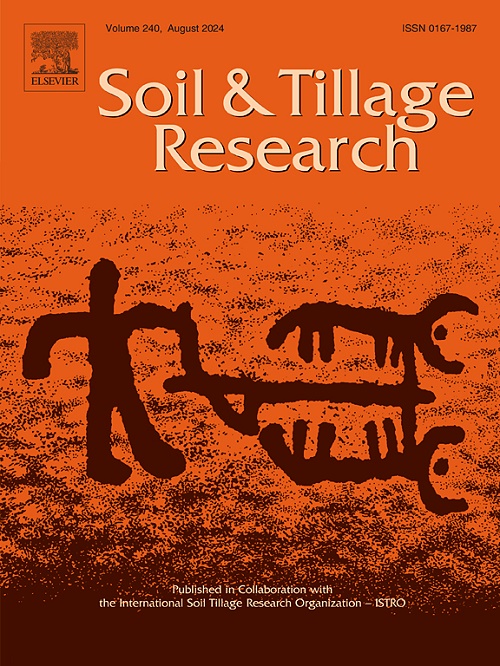Interaction between biochar and nitrogen fertilizer improves nitrogen utilization efficiency, closely connected with rhizosphere microbes involved in nitrogen-cycling
IF 6.1
1区 农林科学
Q1 SOIL SCIENCE
引用次数: 0
Abstract
Biochar is an eco-friendly amendment for improving nitrogen (N) utilization efficiency in agricultural ecosystems. However, the responses of N-cycling functional profiles of rhizosphere microbes to the co-application of biochar and N fertilizer remain greatly elusive. In this study, we designed a rhizo-box experiment with two biochar levels (0 and 2 %) and four nitrogen fertilizer application rates (N1, 0 mg kg−1; N2, 50 mg kg−1; N3, 100 mg kg−1; and N4, 200 mg kg−1) to investigate the effects of biochar and N fertilizer co-application on plant growth, nitrogen utilization efficiency, and rhizosphere microbial nitrogen-cycling functions. The results showed that biochar addition significantly promoted root biomass by 138.7 %, 192.6 %, 24.8 %, and 19.9 % under the N1, N2, N3, and N4 treatments, respectively. Additionally, nitrogen utilization efficiency was improved by 247.1 % and 29.3 % with biochar application under the N2 and N4 treatments. Meanwhile, metagenomic results revealed that rhizosphere microbes exhibited enhanced functions related to glutamate degradation, nitrate reduction and denitrification under the co-application of biochar and N fertilizer, while N fixation functions were inhibited. The variations in microbial N-cycling functions were driven by changes in key taxa involved in N-cycling (e.g., Sphingomonas, Sinomonas, and Streptomyces), which were closely correlated with NH4+-N and NO3--N concentrations. Therefore, our results indicate that the improvement in nitrogen utilization efficiency due to the interaction between biochar and nitrogen fertilizer can be attributed to root proliferation, increased nitrogen availability, and feedback effects from rhizosphere microbes involved in nitrogen cycling.
生物炭与氮肥的相互作用提高了氮素利用效率,与参与氮循环的根际微生物密切相关
生物炭是提高农业生态系统氮素利用效率的生态友好型改良剂。然而,根际微生物氮循环功能谱对生物炭和氮肥配施的响应尚不清楚。在本研究中,我们设计了2种生物炭水平(0和2 %)和4种氮肥施用量(N1, 0 mg kg−1;N2, 50 mg 公斤−1;N3, 100 毫克公斤−1;和N4, 200 mg kg−1),研究生物炭与氮肥共施对植物生长、氮素利用效率和根际微生物氮循环功能的影响。结果表明,在N1、N2、N3和N4处理下,添加生物炭对根系生物量的促进作用分别为138.7 %、192.6 %、24.8 %和19.9 %。此外,在N2和N4处理下,生物炭的氮素利用率分别提高了247.1 %和29.3 %。与此同时,宏基因组研究结果显示,生物炭与氮肥配施显著增强了根际微生物的谷氨酸降解、硝酸盐还原和反硝化功能,抑制了固氮功能。微生物N循环功能的变化是由参与N循环的关键类群(如鞘单胞菌、单胞菌和链霉菌)的变化驱动的,这些变化与NH4+-N和NO3——N浓度密切相关。因此,我们的研究结果表明,由于生物炭和氮肥的相互作用,氮利用效率的提高可能归因于根增殖、氮有效性的增加以及参与氮循环的根际微生物的反馈效应。
本文章由计算机程序翻译,如有差异,请以英文原文为准。
求助全文
约1分钟内获得全文
求助全文
来源期刊

Soil & Tillage Research
农林科学-土壤科学
CiteScore
13.00
自引率
6.20%
发文量
266
审稿时长
5 months
期刊介绍:
Soil & Tillage Research examines the physical, chemical and biological changes in the soil caused by tillage and field traffic. Manuscripts will be considered on aspects of soil science, physics, technology, mechanization and applied engineering for a sustainable balance among productivity, environmental quality and profitability. The following are examples of suitable topics within the scope of the journal of Soil and Tillage Research:
The agricultural and biosystems engineering associated with tillage (including no-tillage, reduced-tillage and direct drilling), irrigation and drainage, crops and crop rotations, fertilization, rehabilitation of mine spoils and processes used to modify soils. Soil change effects on establishment and yield of crops, growth of plants and roots, structure and erosion of soil, cycling of carbon and nutrients, greenhouse gas emissions, leaching, runoff and other processes that affect environmental quality. Characterization or modeling of tillage and field traffic responses, soil, climate, or topographic effects, soil deformation processes, tillage tools, traction devices, energy requirements, economics, surface and subsurface water quality effects, tillage effects on weed, pest and disease control, and their interactions.
 求助内容:
求助内容: 应助结果提醒方式:
应助结果提醒方式:


